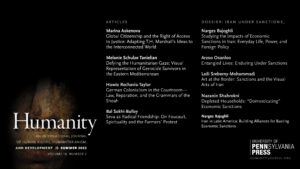Abstract: This essay examines the transnational movement against prisoner abuse and torture in Pahlavi Iran in the 1960s-1970s. Arguing that the notion of human rights in this era was neither fixed nor stable, it analyzes the encounter between Iranian revolutionaries, students, and intellectuals and international human rights activists and organizations. It argues that the growing prominence of prisoner abuse in Iran provided a rallying point for Iranian dissidents of various political stripes in the years before the 1979 revolution as well as a testing ground for the emergent global human rights movement at a time when this movement had not yet cohered into the industry it is today.
Current Issue

Our long-awaited issue of Humanity journal is out! Its special dossier, Iran under Sanctions, examines the myriad and devastating impacts of international sanctions on society, culture, and politics. The issue includes an essay on the legal case Herero and Nama v. The Federal Republic of Germany to theorize reparations for German colonialism and slavery as they became linked with the aftermath of the Shoah. It also includes essays on T.H. Marshall and the right of access to justice; visual representations of Armenian genocide survivors; and, the concept of radical friendship in relation to the Farmers’ Protests in India.
View entire issue > Save Save Save
📘'Choose Your Bearing: Édouard Glissant, Human Rights and Decolonial Ethics' is now available for pre-order!
❕Grab your copy and save 30% OFF using the code NEW30 at checkout : https://edin.ac/3JIcRne
@HumanityJ